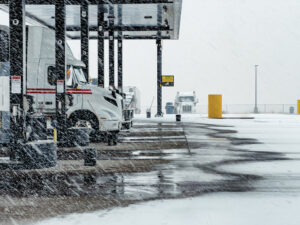Everything’s going great — you’re even ahead of schedule, cruising along in moderate traffic, enjoying the day.
Then it happens.
Brake lights ahead indicate stopped traffic … and there it is: a highway clusterfuddle in the middle of nowhere. So, there you sit, creeping inch by inch toward your destination instead of cruising along on the open road.
By the time you finally get through all the traffic and spot the two smashed-up four-wheelers that caused the whole mess, sitting on the shoulder of the highway, your schedule is shot. You no longer have enough hours to legally and safely complete the trip because of hours-of-service rules.
Or do you?
Thanks to a little-understood provision in the Federal Motor Carrier Safety Regulations (better known as the FMCSRs), you just might have up to two extra hours of driving. Your 14-hour drive/work period can also be extended by up to two hours. Unfortunately, some drivers don’t understand this rule and avoid using it to stay away from logging violations. At the other extreme are drivers who use the provision often but use it incorrectly, inviting problems later when logs are audited. A third group understands and uses the provision but isn’t clear on how to record it.
According to the Federal Motor Carrier Safety Administration, adverse driving conditions are defined as “snow, ice, sleet, fog, or other adverse weather conditions or unusual road or traffic conditions that were not known, or could not have reasonably been known, to a driver immediately prior to beginning the duty day, or immediately before beginning driving after a qualifying rest break or sleeper berth period, or to a motor carrier immediately prior to dispatching the driver.”
Notice the “unusual road or traffic conditions” part of that rule.
Before claiming the extra driving and on-duty time, the first question a driver should ask is whether the condition was (or could have been) known before the driving day began. Weather, for example, is predicted almost constantly by government agencies and reported frequently by media outlets. If heavy snow was predicted for your route yesterday, you won’t be able to claim extra time for the adverse conditions you faced. The standard is “could not have reasonably been known,” so claiming you didn’t hear a weather report won’t work as an excuse. The information was available, if you had looked for it.
On the other hand, if the weather report had called for rain, but the temperature dropped lower than expected and the rain turned into a surprise snowstorm, that’s a legitimate use of the exemption.
Another example is traffic congestion. If your trip takes you along I- 80/94 south of Chicago and into northwest Indiana at 5:30 in the afternoon, you won’t be able to claim that traffic congestion was a surprise. Every driver knows to expect heavy traffic during rush hour in a metro area. On the other hand, a backup caused by an accident on I-80 in rural Iowa isn’t as predictable and could be used for the exemption.
Things you definitely can’t use to extend driving and working hours are events like delays in loading or unloading, breakdowns, personal illness, etc.
As any professional driver knows, traffic backups can occur anywhere, and for a variety of reasons. Vehicle collisions are often the cause, as is construction, nature events such as rock or mudslides, trees falling into the roadway, stoppages for presidential motorcades and a host of others. As long as you could not have known before your trip or your latest driving period, began, you can claim the extra time.
Another caveat of the exemption is that, in order to claim the extra time, you be able to prove you would have been able to finish your trip within the regulated hours had the adverse condition not occurred. If it’s Wednesday and your delivery is scheduled for Friday, you can’t drive extra time due to adverse conditions. It only applies if you can reach your delivery without another rest break.
Something to remember about using the adverse driving conditions exemption is that the reason claimed for driving the extra hours can — and will — be checked. Law enforcement personnel usually have computers that are connected to state offices, or at least radio contact with people who have access. Your claim of a huge traffic jam at mile marker 162 caused by loose cows in the roadway can be checked, and you can receive a citation if it can’t be shown as legitimate. You can argue, of course, but a day in the courtroom, even if you win your case, can still cost you a day’s pay plus travel and potential lodging expenses. You’ll want to save all the evidence you can about your reason for claiming the exemption.
Carriers often use outside services to check electronic log data and alert their safety department or other designated staff when carrier-specified events occur. For example, if you work for a large carrier that had 50 trucks travel the same stretch of highway that day and you’re the only one who claimed the hours-of-service exemption because of a traffic backup (or a tornado, or a blizzard), your version of events could be questioned. Again, the answer is to document the event as best you can.
You can use the internet to search for and save stories about the event. Weather events are often newsworthy, especially if they are severe. A screenshot of a page from the state’s department of transportation website reporting unexpected events could be helpful. Photos from your phone, in certain conditions, may be enough, especially if you can get mile marker signs or other location information in the picture. You don’t need to spend hours building a case, but it doesn’t hurt to save evidence to back up your claim of adverse driving conditions.
Finally, remember that the additional hours you claim will still count against your seven- or eight-day totals. You could run out of available hours sooner than expected.
The exception to the hours of service for adverse driving conditions is a great tool that can save the day when on-time delivery is at stake, but it must be used correctly to avoid violations of the regulations and, in some cases, carrier policies. For drivers who know how to use the rule and document the exceptions, it can be a great tool in the professional driver’s toolbox.
Cliff Abbott is an experienced commercial vehicle driver and owner-operator who still holds a CDL in his home state of Alabama. In nearly 40 years in trucking, he’s been an instructor and trainer and has managed safety and recruiting operations for several carriers. Having never lost his love of the road, Cliff has written a book and hundreds of songs and has been writing for The Trucker for more than a decade.














